As Stevie Wonder put it in his classic song “Sir Duke,” “Music is a world within itself / with a language we all understand.”
If music transcends language, then writing about it might seem strange.
Still, there can be a lot of value in creating a music blog.
Whether it’s to promote your band, sell music-related products, or just to share your thoughts on music with the world, a music blog could be the way to do it.
Music can be a tricky subject to write about, however.
To give you some inspiration for your own music blog, we want to share eight different types of music content that work well for a variety of purposes.
With each type of content, we’ve included an example from our favorite blogs, both well-known and obscure.
What all have in common, however, is that they demonstrate a high quality of content for you to emulate.
What Type of Music Blog Posts Should You Write?
The type of content you choose to create will depend on your reasons for starting a music blog.
If you’re looking to promote your own work, for example, then posting updates about progress on your latest album or a behind-the-scenes look at how you produced your hit song would make sense.
If you sell music products, on the other hand, then posting instrument or gear reviews would be a smart way to go, as would interviews with a prominent musician who uses your products.
That being said, don’t be afraid to get creative.
Just because you’re primarily a music news site, that doesn’t mean you can’t also post behind-the-scenes content if it makes sense to do so.
The key is to understand what your audience wants to read, and that’s something you can only figure out with time and experimentation.
Knowing that, let’s look at 8 music blog post ideas for you to try:
1. Music News
The world of music is dynamic, with a constant stream of new albums, concerts, and product releases.
This makes news a logical type of blog content for some sites.
Most music blogs that post news tend to be focused on that type of content, though you’ll often find that such blogs post interviews and other story-driven articles.
News could also make sense if you review instruments or gear, as your readers will want to know about the release of the latest guitar, drums, or effects pedal.
Types of news blog posts include:
- Tour, concert, or other live event announcements
- Album or song announcements
- New music video announcements
- Product release announcements
- Notice of the death or retirement of a musician or band
- Gossip or personal life information related to musicians (if you’re running a blog with an audience interested in that sort of content)
To see what a quality music news blog post looks like, check out Stereogum’s announcement of two new tracks from Childish Gambino:

This post keeps things short and simple.
It begins with a statement of the news item: There are two new Childish Gambino songs.
The author then gives a bit of info about what the songs sound like, followed by some context about how they think people will receive the songs (note the internal links to other related posts on the site).
Finally, the author notes how the two songs fit into the overall context of Gambino’s music before Take note, also, of what this post is not. It’s not a review of the two songs. While the author does give a couple sentences about the musical style of the tracks in question, they don’t go into detail or give qualitative judgments. Rather, they make the announcement and then get straight to what most readers care about: How to listen to the new songs. Everyone loves free stuff, even if we know deep down that “free” products still come with some sort of cost. This is what makes giveaways so effective: Just find an artist or company willing to give away a relevant product or experience, and then partner with them to offer it to your readers. It’s easier said than done, but it can be a great way to make money through sponsorships, attract new readers to your blog, and build relationships with members of the local music scene. Here are some ideas for giveaways: Of course, in most cases there are certain conditions that your readers must meet in order to be eligible for the giveaway. This could involve sharing a post on social media, joining your email list, or leaving a comment on your blog. Whatever the condition is, make sure that it furthers your blog and/or business goals in some way. To see an example of a classic giveaway post, let’s look at a recent contest from LA Music Blog offering the chance to win tickets to see Django Django: The post begins with an overview of who the band in question is, as well as what you can win. In this case, it’s concert tickets, and the author wastes no time getting to what you need to do to win them: Whenever you run a contest or giveaway, you must be specific about two things: This post does both. First, there are the three conditions for entering, all of which work to boost the site’s social media presence. Second, there’s a clear statement of what winners receive: concert tickets only (no travel or accommodation). If you don’t include information like this, you could risk some upset readers who misunderstood your contest. It’s best to err on the side of over-explaining in cases like these. Tutorials are a popular type of blog post for a reason: They help people accomplish things they lack the knowledge to do. If you can write a tutorial explaining how to create a beat, master a particular scale, or record a professional vocal, your readers will keep coming back. Here are some types of tutorials you can create: For an example of what a tutorial post should be, check out this step-by-step guide to home music mastering from musician and producer Andrew Huang: Andrew begins the tutorial with an explanation of the problem that his readers want to solve. In this case, it’s how to spend less time and effort on the mastering part of producing a track. This is what he goes on to explain as he details his four-stage mastering process. Throughout the post, he includes screenshots of his mastering setup: This is a good example to emulate. No matter what you’re writing a tutorial about, it’s essential that you use screenshots, video, and other media to illustrate your points. You never want readers to be unsure about the steps they’re supposed to take. Back in the days when vinyl was the main form of recorded music, you could always count on the album sleeve to give you insight into the record’s production process. It was common to see photos of the band in the studio, as well as notes from the producer. Even when CDs replaced vinyl, this same tradition lived on in the booklets that would accompany CDs. When music went digital, so did behind-the-scenes info. These days it no longer comes with the album. Instead, behind-the-scenes material is available online, often from a variety of media outlets (some affiliated with the music, some not). Whether you’re looking to promote your own music or just to inform and entertain your readers, behind-the-scenes posts have a lot of value. Your fans and readers love to get insight into the creative process, as it helps them feel that they’re a greater part of the music, more than just consumers. This is especially important for new artists, as it’s a chance to give fans the backstory of who you are and where your music comes from. Here are some ideas for behind-the-scenes posts: To see a behind the scenes post in action, check out this “Making Of” post that Genius did for SZA’s “The Weekend”: This post starts with an attention-grabbing heading, and then it proceeds into a brief explanation of the song’s popularity and context. From there, the author introduces the producer they’ll be interviewing. Note how this post relies on storytelling, weaving the quotes from the producer into the writing. There are also links to the artists and songs that the producer cites as influences, allowing the reader to learn more about them if they want. We should also mention that this post exists alongside a video interview with the song’s producer. If you can show yourself (or your production team, or any people) on camera, it creates a greater connection than words alone. We all love to connect with the people behind the music. In most cases, that’s not practical to do in person. This is where interviews come in. They allow you to learn about artists, producers, or even instrument manufacturers, all in a format that can spark new ideas and provide entertainment. What you talk about in an interview will vary based on the topic of your blog and the person or group that you’re interviewing. The best interviews are those that strike a balance between allowing the interviewee to speak while still moving the focus back to particular questions when necessary. Let’s look at a quality interview in the real world. Here’s an interview with the band Imagine Dragons published in “NME”: The title pulls you in, which is essential for any blog post you write. It’s especially important with interviews, however, as you want your readers to know they’ll be getting something more interesting than info on the interviewee’s favorite breakfast cereal. One notable thing about this interview in terms of format is how it’s based around lyrics from the band’s latest album. For each section, a particular lyric sets the theme for the interview questions: If you’re interviewing a musician, this can be an effective approach to take. It may not work for all bands, though, as not all lyrics are autobiographical. You can make sure to ask quality questions by thoroughly researching the interviewee beforehand (including any other interviews they’ve given, so that you can avoid redundancy in your questions). Love them or hate them, list posts work. They provide a predictable formula based around a compelling premise. This winning formula works just as well for music blogging as for any other subject. Lists of best bands of a particular decade, best new albums of the year, or top guitars for newbies all translate into clickable headlines for articles that people will read. Here are some list post ideas to consider for music blogging: You can create endless variations on the above by adding a few choice adjectives specifying the genre of music or type of artist. For instance, here’s a list post we like from “Paste” that explores 10 albums that turn 10 this year: Posts like this work well because they play on the reader’s sense of nostalgia. It takes them back to what they were doing and where they lived when they listened to these albums for the first time. The author heightens this feeling by adding some broader musical context for each album, such as these notes about how the album “Fleet Foxes” signaled a new era of indie folk: You’ll also note the numerous internal links, which raises another key point about list posts: They’re a great way to direct readers to other content on your site. In a world where you can stream millions of songs at the tap of a button, there’s more of a need than ever for quality music reviews. A good review can help you sort through the deluge of new and existing music, saving you the time you would otherwise have to spend listening to entire albums just to find the couple tracks you like. When writing a review, you need to keep three things in mind: There’s plenty of room for clever wordplay and fancy musical terminology, but the best reviews use those to complement a piece that meets the three above criteria. Ultimately, the person reading your review cares less about your beautiful prose and more about how you can help them decide whether or not they should listen to the new album, song, or EP. To see an example of such a post, here’s Consequence of Sound’s review for Florence + the Machine’s album “High Hope”: We love how this review provides a visual summary of key information at the beginning. The title indicates that the album could have been better, and the prominent “B-” on the album cover makes the overall rating clear. You could do the same for your blog using a letter grade or number system. Reading on, however, you learn more about the reason for this rating. The review is split into four parts: You don’t have to use a format like this for your post, but a good review will include all of the above information. For our final type of music blog content, we have instrument and gear reviews. These posts can serve both a valuable informational function for your readers and a profitable commercial function for your blog, whether through affiliate links, sponsorships, or other money-making activities. In many cases, musical equipment is expensive. Therefore, people want to do as much research as they can before making a purchase. This is where your blog can provide a much-needed service, helping people make informed buying decisions on the instruments or gear that they desire. Here are some types of instrument and gear reviews you can do: To observe this on an actual blog, here’s Music Critic’s buying guide to the 10 best alto saxophones: This post begins with an explanation of the methodology that the authors used to choose the 10 saxophones they discuss in the review. You should always include such an explanation whenever you do a review post. Not only does it boost the reader’s confidence in your authority, but it also gives the reader information that they could use to make their own buying decisions. After that, the review proceeds with a detailed look at each instrument, beginning with a photo: Quality photos are essential for reviews, as they help the reader visualize the product in their hands. They also help to break up longer review posts, which could get monotonous otherwise. Videos are even better, allowing you to show the product from multiple angles or even how it works or sounds when in use. In addition to the images, each review includes a list of “Pros” as well as a general summary of why the reviewer liked the saxophone: Using bullet points is another good idea for reviews, as many people will end up skimming them in search of specific features or out of a general desire to save time. Some particularly dedicated people might read the entire post from start to finish, but they’re definitely the exception. Finally, it’s worth noting that the above post contains Amazon affiliate links to all the products it discusses. Reviews can be powerful drivers of affiliate revenue for your blog, as they so often discuss products. And with musical equipment being higher in price than a lot of typical affiliate products, you have the opportunity to make money if you create reviews that are valuable enough. Starting a music blog is a chance to share your knowledge and love of music with the world. There are many types of content you can create; we hope the eight we covered in this post have given you the inspiration you need to get started. Now, all you need to do is choose a blogging platform such as WordPress, set up hosting, and write your first post. If you’re looking for more information on how to start a blog, grow your audience, or make money online, then we suggest you sign up for our newsletter. We’ll send you a weekly email with the latest tips on blogging success, as well as exclusive promotions and discounts. Creating a successful new blog isn’t something that will happen overnight, but the time and effort can be worth it to promote your music, sell your products, or inform the world about the best music around. You just need to be persistent and keep experimenting. Before long, you’ll be able to see the results of your hard work pay off.
2. Giveaways

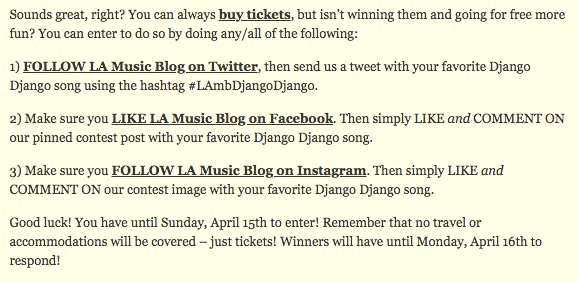
3. Tutorials


4. Behind the Scenes

5. Interviews


6. Lists and Roundups

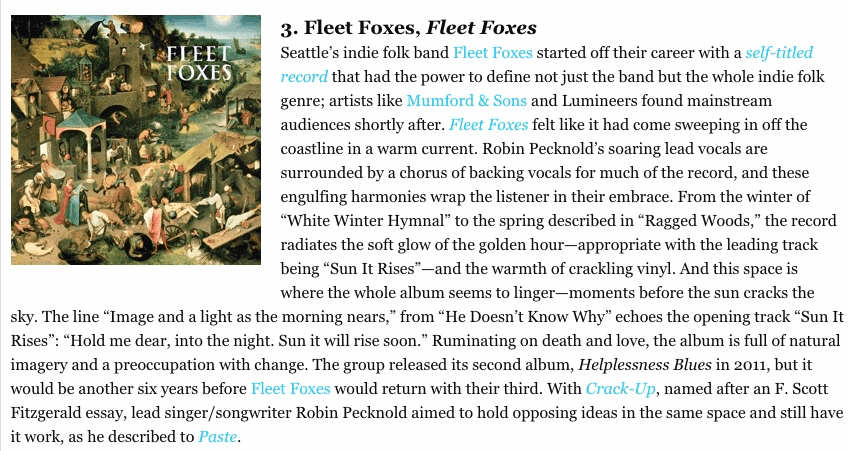
7. Album and Song Reviews

8. Instrument and Gear Reviews
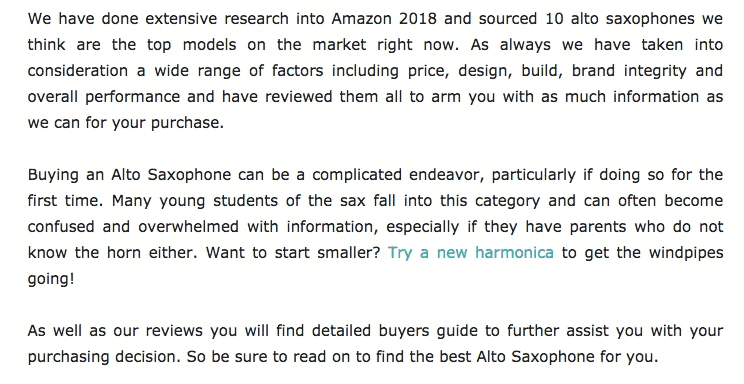
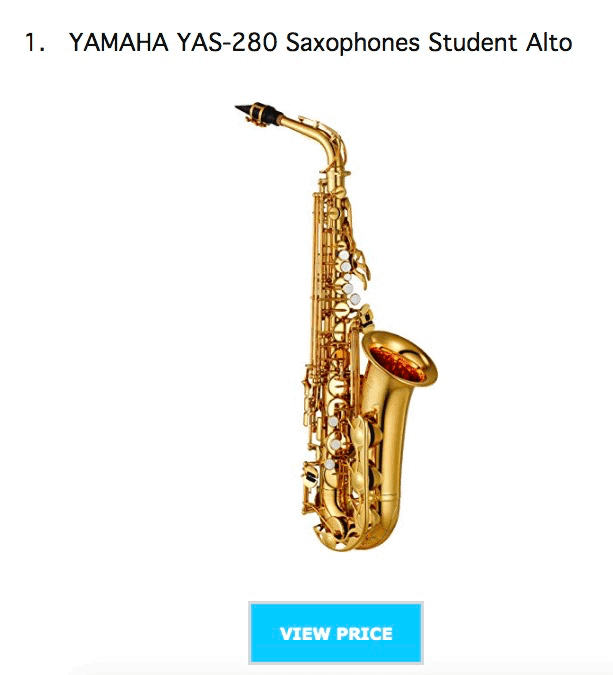
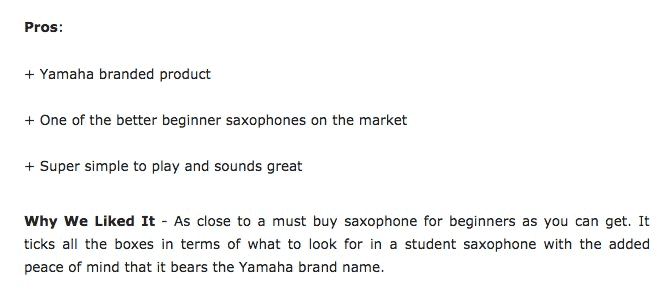
Start Creating Your Music Blog Today







